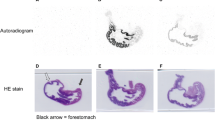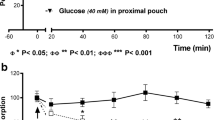Summary
-
1.
The effects of gastrin I, bethanechol, histamine and reserpine on gastric acid secretion and the expiration of radioactive carbon dioxide have been studied in anaesthetized carboxyl-14C-l-histidine-loaded rats.
-
2.
All compounds tested stimulated gastric acid secretion. In unstimulated animals the radioactive carbon dioxide in the expired air dropped exponentially with time; it was increased by reserpine and histamine, but not by gastrin and bethanechol.
-
3.
In gastrin- and histamine-treated animals acetazolamide suppressed gastric acid secretion as well as the expiration of radioactive carbon dioxide.
-
4.
The effect of histamine on the expiration of radioactive carbon dioxide can be attributed to effects other than the enhanced decarboxylation of histidine. The response to reserpine can be explained as an activation of histidine decarboxylase. Whether the failure of gastrin I and bethanechol to increase the expiration of radioactive carbon dioxide documents their inability to stimulate histidine decarboxylase in vivo, cannot be decided.
Similar content being viewed by others
References
Albinus, M., Sewing, K.-Fr.: The effect of SC-15396, atropine and mepyramine on gastrin-, bethanechol- and histamine-stimulated gastric acid secretion in rats and guinea pigs. J. Pharm. Pharmacol.21, 656–661 (1969).
Brunton, C. E., Israels, M. C. G.: Interrelations of respiration and gastric secretion J. Physiol. (Lond.)70, 184–194 (1930).
Carter, E. T.: Regulation of respiration during carbonic anhydrase inhibition. Fed. Proc.13, 23 (1954).
Davies, R. E., Edelman, J.: The function of carbonic anhydrase in the stomach. Biochem. J.50, 190–194 (1951).
Dobrescu, D.: A propos de l'action de l'histamine sur l'anhydrase carbonique. C. R. Soc. Biol. (Paris)160, 220 (1966).
—: Influence de substances sécrétagogues gastriques sur l'anhydrase carbonique. Arch. int. Pharmacodyn.166, 167–171 (1967).
Emås, S.: Effect of acetazolamide on histamine-stimulated and gastrin-stimulated gastric secretion. Gastroenterology43, 557–563 (1962).
Grossman, M. I.: Gastrin and its activities. Nature (Lond.)228, 1147–1150 (1970).
Herberg, R. J.: Determination of carbon-14 and tritium in blood and other whole tissues. Analyt. Chem.32, 42–46 (1960).
Jacobson, E. D.: Secretion and blood flow in the gastrointestinal tract. In: C. F. Code (Ed.): Handbook of Physiology, Section 6, Vol. II, pp. 1043–1062. American Physiological Society. Washington: 1967.
Janowitz, H. D., Colcher, H., Hollander, F.: Inhibition of gastric secretion of acid in dogs by carbonic anhydrase inhibitor, 2-acetylamino-1,3,4-thiadiazole-5-sulfonamide. Amer. J. Physiol.171, 325–330 (1952).
Lai, K. S.: Studies on gastrin. Gut5, 327–341 (1964).
Lorenz, W., Pfleger, K.: Stoffwechsel und physiologische Funktion von Histamin im Magen. Klin. Wschr.46, 57–71 (1968).
McQuarrie, D. G., Eichenholz, A., Blumentals, A. S., Vennes, J. A.: Kinetics of gastric juice secretion: a correlation of arteriovenous differences with the composition of the gastric juice. Surgery62, 475–486 (1967).
—: The contributions of anaerobic mechanisms to hydrogen ion transport in the dog stomach. J. Lab. clin. Med.75, 61–73 (1970).
Radwan, A. G., West, G. B.: The effect of aminoguanidine, histamine, chlorpromazine and antibacterial agents on histidine decarboxylase in the stomach of the rat. Brit. J. Pharmacol.33, 177–183 (1968).
Reilly, M. A., Schayer, R. W.: Studies on the histidine-histamine relationship in vivo. Brit. J. Pharmacol.32, 567–574 (1968).
Sewing, K.-Fr.: The effect of gastric secretagogues on gastric mucosal histamine and histidine decarboxylase activity in rats. Life Sci.8, 783–789 (1969).
Shepherd, D. M., Woodcock, B. G.: Histamine formation in normal and totally gastrectomized rats. Arch. int. Pharmacodyn.174, 50–61 (1968).
Tomashefski, J. F., Chinn, H. I., Clark, R. T.: Effect of carbonic anhydrase inhibition on respiration. Amer. J. Physiol.177, 451–454 (1954).
Author information
Authors and Affiliations
Additional information
This work was supported by a grant from the Deutsche Forschungsgemein-schaft and the Universitätsbund Tübingen.
Rights and permissions
About this article
Cite this article
Albinus, M., Sewing, K.F. Gastric acid secretion and the expiration of radioactive carbon dioxide of carboxyl-14C-labelled histidine-loaded rats. Naunyn-Schmiedebergs Arch. Pharmak. 271, 149–156 (1971). https://doi.org/10.1007/BF00998576
Received:
Issue Date:
DOI: https://doi.org/10.1007/BF00998576




